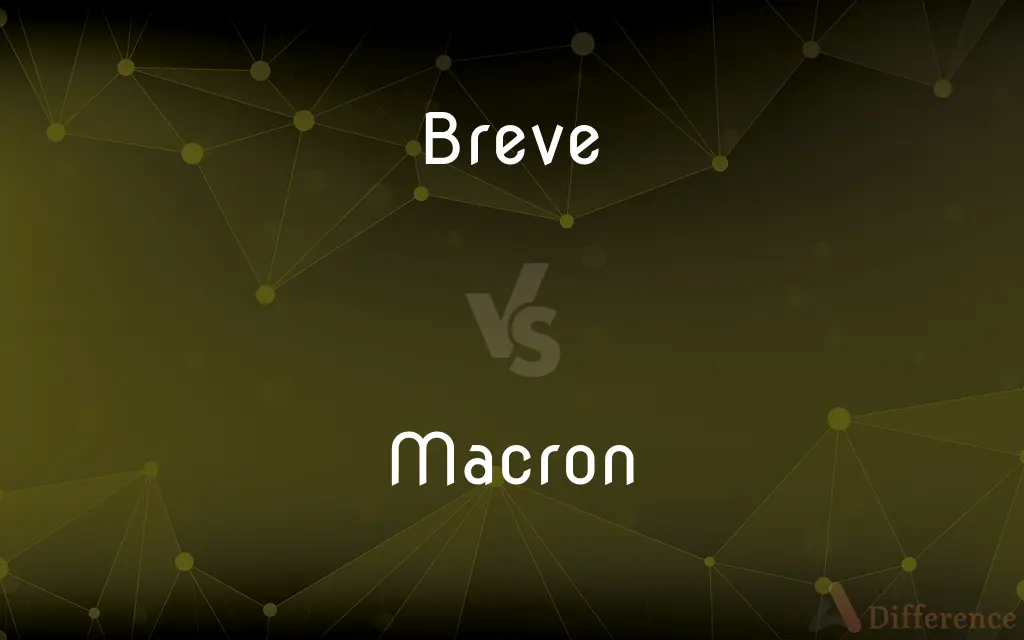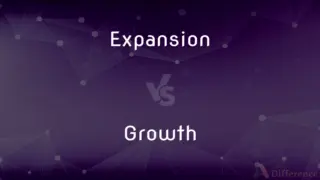Breve vs. Macron — What's the Difference?
By Maham Liaqat & Fiza Rafique — Updated on March 14, 2024
A breve is a diacritical mark (˘) indicating a short vowel sound, while a macron (¯) denotes a long vowel sound in phonetic transcription and various languages.

Difference Between Breve and Macron
Table of Contents
ADVERTISEMENT
Key Differences
Breves and macrons serve as diacritical marks in written language, primarily to indicate vowel length. The breve, shaped like a small, rounded arch (˘), is used above a vowel to signify that the vowel is short or unstressed. In contrast, the macron is a horizontal line (¯) placed above a vowel to indicate that it is long or has a prolonged duration. These markings are particularly useful in languages where vowel length can change the meaning of words, as well as in phonetic transcriptions to aid pronunciation.
While breves are less commonly used in modern languages, they are found in linguistic studies, dictionaries, and the transcription of languages like Romanian and occasionally in Turkish. Macrons are more widely used, appearing in languages such as Māori, Hawaiian, and Latin, where they play a crucial role in distinguishing between words and guiding correct pronunciation.
The application of a breve can change the meaning or class of a word in languages that depend on vowel length, although its use is more limited compared to the macron. The macron, by indicating a longer vowel sound, often impacts the meaning, pronunciation, and even the grammatical role of words in the languages that employ it.
Both diacritical marks are integral to the phonetic representation of words, ensuring clarity and precision in pronunciation. Their presence or absence can significantly alter the interpretation and understanding of words in the languages and contexts where they are used.
Comparison Chart
Function
Indicates a short or unstressed vowel sound.
Denotes a long vowel sound.
ADVERTISEMENT
Shape
Rounded arch above a vowel.
Horizontal line above a vowel.
Usage
Less common, used in linguistic studies and some languages.
More widely used in languages like Māori, Hawaiian, and Latin.
Linguistic Impact
Can change the meaning or class of a word by shortening a vowel.
Affects meaning, pronunciation, and grammatical role with long vowels.
Examples
Romanian, Turkish (occasionally).
Māori, Hawaiian, Latin.
Compare with Definitions
Breve
A diacritical mark (˘) indicating a short or unstressed vowel sound.
In phonetic transcription, a breve over the letter a (ă) signifies a shorter pronunciation.
Macron
A diacritical mark (¯) used to indicate a long vowel sound.
In Latin, ā indicates a longer a sound, as in āmō (I love).
Breve
Used in certain languages to differentiate vowel lengths.
In Romanian, a breve over a distinguishes the sound in măr (apple) from mar (march).
Macron
Employed in phonetic transcriptions and language teaching.
Language textbooks use macrons to aid pronunciation of long vowels in foreign languages.
Breve
Occasionally used in the transcription of historical texts.
Medieval manuscripts might use a breve to indicate vowel pronunciation or length.
Macron
Essential in languages like Māori and Hawaiian for correct pronunciation.
In Māori, mākū (wet) is distinguished from maku (my younger sibling) by a macron.
Breve
Appears in linguistic and phonetic studies to denote specific vowel sounds.
Linguists use the breve to indicate unstressed syllables in word transcriptions.
Macron
Influences the meaning and grammatical interpretation in certain languages.
In Hawaiian, kāne (man) differs significantly from kane (husband) due to the macron.
Breve
A breve ( (listen), less often (listen), neuter form of the Latin brevis "short, brief") is the diacritic mark ˘, shaped like the bottom half of a circle. As used in Ancient Greek, it is also called brachy, βραχύ.
Macron
A symbol ( ¯ ) placed over a vowel to show that it has a long sound.
Breve
A symbol ( ˘ ) placed over a vowel to show that it has a short sound.
Macron
The horizontal mark ( ¯ ) used to indicate a stressed or long syllable in a foot of verse.
Breve
A curved mark used to indicate a short or unstressed syllable of verse.
Macron
(orthography) A short, straight, horizontal diacritical mark (◌̄) placed over a letter, usually to indicate that the pronunciation of a vowel is long.
Breve
(Music) A note equivalent to two whole notes.
Macron
A short, straight, horizontal mark [-], placed over vowels to denote that they are to be pronounced with a long sound; as, ā, in dāme; ē, in sēam, etc.
Breve
A semicircular diacritical mark (˘) placed above a vowel, commonly used to mark its quantity as short.
Macron
A diacritical mark (-) placed above a vowel to indicate a long sound
Breve
(music) A double whole note; a note twice as long as a semibreve.
Breve
(legal) Any writ or precept under seal, issued out of any court.
Breve
(zoology) A pitta, all of which have more or less short tails.
Breve
An equal mix of espresso and half and half cream
Breve
A note or character of time, equivalent to two semibreves or four minims. When dotted, it is equal to three semibreves. It was formerly of a square figure (as thus: ), but is now made oval, with a line perpendicular to the staff on each of its sides; - formerly much used for choir service.
Breve
Any writ or precept under seal, issued out of any court.
Breve
A curved mark [
Breve
The great ant thrush of Sumatra (Pitta gigas), which has a very short tail.
Breve
A diacritical mark (u-curved) placed over a vowel to indicate a short sound
Common Curiosities
Why are breves and macrons important in language?
They guide pronunciation, indicate vowel length, and can alter the meaning of words, aiding in clear communication and understanding.
How are breves and macrons typed on a keyboard?
Depending on the language settings and software, they can often be typed using special keyboard shortcuts or character maps.
Do breves and macrons appear in digital texts?
Yes, they can appear in digital texts, especially in educational materials, language courses, and online linguistic resources.
Do all languages use breves and macrons?
Not all languages use these diacritical marks; their usage is specific to languages where vowel length impacts meaning or pronunciation.
Can a single language use both breves and macrons?
While uncommon, some languages or linguistic studies might use both to distinguish between short and long vowel sounds.
How does a macron affect pronunciation?
A macron lengthens the vowel sound, which can change the word's pronunciation, meaning, and sometimes its grammatical function.
Can the absence of a breve or macron change a word's meaning?
Yes, in languages where vowel length is significant, the absence of these marks can lead to misunderstandings or mispronunciations.
Are breves used in English?
Breves are not commonly used in modern English but may appear in linguistic studies or dictionaries for phonetic purposes.
Are there any rules for the use of breves and macrons?
Usage rules vary by language and context, typically following standard linguistic guidelines or specific language orthographies.
Can the use of a breve or macron change over time?
Language conventions can evolve, potentially altering the usage, significance, or frequency of diacritical marks like breves and macrons.
Share Your Discovery

Previous Comparison
Expansion vs. Growth
Next Comparison
Hijab vs. TurbanAuthor Spotlight
Written by
Maham LiaqatCo-written by
Fiza RafiqueFiza Rafique is a skilled content writer at AskDifference.com, where she meticulously refines and enhances written pieces. Drawing from her vast editorial expertise, Fiza ensures clarity, accuracy, and precision in every article. Passionate about language, she continually seeks to elevate the quality of content for readers worldwide.














































